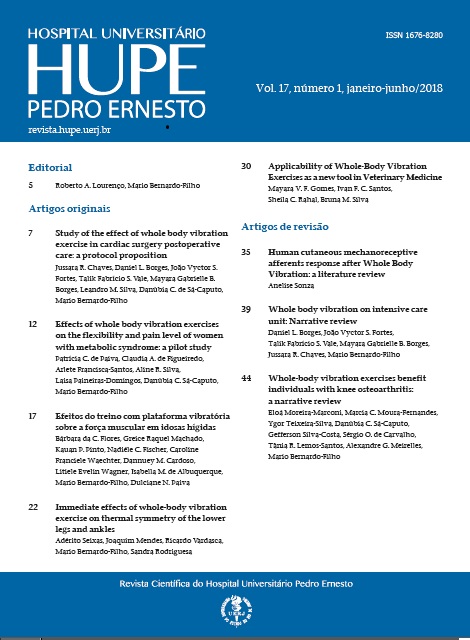Study of the effect of whole body vibration exercise in cardiac surgery postoperative care: a protocol proposition
DOI:
https://doi.org/10.12957/rhupe.2018.39167Abstract
Abstract
Introduction: Cardiac surgery is of great importance in the
treatment of cardiovascular disease, which contribute to
the increase of morbimortality. The mechanical vibration
generated by an oscillating/vibratory platform causes the
production of whole body vibration and can be used as a
physical exercise modality (WBVE). Objective: To present a
protocol for evaluation of WBVE effects in postoperative patients
of cardiac surgery. Methods: Adult subjects undergoing
cardiac surgery post-op who are discharged from the Intensive
Care Unit on up to the fourth day will be randomly assigned
to two groups: the control group (CG) who will receive conventional
physiotherapeutic care; the intervention group
(IG), in addition to the conventional care, will be submitted
to the WBVE. IG patients will remain with their knees flexed
at 15° on the side-alternating oscillating/vibratory platform.
They will perform three rounds of 1 min (for 1 min rest) at 5
Hz and 8 mm of peak-to-peak displacement, twice a day. Each
day, the sessions will increase, reaching a maximum of seven
series of 1 min and 9 Hz, on the seventh postoperative day. We
will evaluate respiratory muscle strength, lung function, peripheral
muscle strength, functional capacity and sensation of
pain through manovacuometry, spirometry, dynamometry,
Time Up and Go (TUG), Functional Independence Measure
(FIM), Visual Analog Pain Scale (VAS), and POWERbreathe
K5. Discussion: Studies have demonstrated beneficial effects
with EVCI in different clinical conditions, and it’s a promising
form of intervention during the rehabilitation of patients
in the postoperative period of cardiac surgery. Conclusion:
The application of this protocol will provide evidence that
justifies a rehabilitation program with WBVE for individuals
undergoing cardiac surgery.
Keywords: Whole body vibration exercises; Exercise therapy;
Intensive Care Unit, Heart surgery.
References
Fortes JV, Silva MG, Baldez TE, et al. Mortality Risk After
Cardiac Surgery: Application of Inscor in a University Hospital
in Brazil’s Northeast. Braz J Cardiovasc Surg. 2016;31:396-9.
Cordeiro AL, Barbosa AF, Leitão LP, et al. Efeitos Hemodinâmicos
do Treino em Cicloergômetro em Pacientes no Pós-Operatório
de Cirurgia Cardíaca. Rev DERC. 2014;20:90-3.
Morais DB, Lopes ACRL, Sá VM, et al. Avaliação do desempenho
funcional em pacientes submetidos à cirurgia cardíaca.
Rev. Bras. Cardiol. 2010;23:263-9.
Laura BA, Fernández PC, Corral TD, et al. Effect of Manual
Therapy, Motor Control Exercise, and Inspiratory Muscle Training
on Maximum Inspiratory Pressure and Postural Measures in
Moderate Smokers: A Randomized Controlled Trial. J Manipulative
Physiol Ther. 2018;4:372-82.
Behboudi L, Azarbayjani MA, Aghaalinejad H, et al. Effects of
aerobic exercise and whole body vibration on glycaemia control
in type 2 diabetic males. Asian J Sports Med. 2011;2:83-90.
Theodorou A, Gerodimos V, Karatrantou K, et al. Acute and
chronic whole-body vibration exercise does not induce
health-promoting effects on blood profile. J Hum Kinet.
;46:107-18
Rittweger J. Vibration as an exercise modality: how it may
work, and what its potential might be. Eur J Appl Physiol. 2010;
:877-904.
Rittweger J, Beller G, Felsenberg D. Acute physiological effects
of exhaustive whole-body vibration exercise in man. Clin Physiol.
;20:134-42.
Rittweger J, Schiessl H, Felsenberg D. Oxygen uptake during
whole-body vibration exercise: comparison with squatting as a
slow voluntary movement. Eur J Appl Physiol. 2001;86:169-73.
Sá-Caputo DC, Costa PR, Lima RPC, et al. Whole body
vibration exercises and the improvement of the flexibility
in patient with metabolic syndrome. Rehabil Res Pract.
;2014:628518. doi: 10.1155/2014/628518.
Brunner S, Brunner D, Winter H, et al. Feasibility of whole-body
vibration as an early impatient rehabilitation tool after lung
transplantation – a pilot study. Clin Transplant. 2016;30:93-8.
ATS/ERS statement on respiratory muscle testing. Am J Respir
Crit Care Med. 2002;166:518-624.
Dias JAD, Ovano AC, Kulkamp W, et al. Força de preensão palmar:
métodos de avaliação e fatores que influenciam a medida.
Rev Bras Cineantropom Desempenho Hum. 2010;12:209-6.
Podsiadlo D, Richardson S. The timed “Up & Go”: a test of
basic functional mobility for frail elderly persons. J Am Geriatr
Soc. 1991;39:142-8.
Riberto M, Miyazaki MH, Jucá SSH, et al. Validação da Versão
Brasileira da Medida de Independência Funcional. Acta Fisiatr.
;11:72-6.
Osório ACM, Flores L, Marin L, et al. Qualidade de vida de
pacientes idosos submetidos à cirurgia de revascularização.
Rev Fisisenectus. 2014;2:13-23.
Cochrane DJ. Vibration exercise: the potential benefits. Int J
Sports Med. 2011;32:75-99.
Boeselt T, Nell C, Kehr K, et al. Whole vibration therapy in
intensive care patients: a feasibility and safety study. J Rehabil
Med. 2016;48:316-21.
Pleguezuelos E, Perez ME, Guirao L, et al. Effects of whole
body vibration training in patients with severe chronic obstructive
pulmonary disease. Respirology. 2013;18:1028-34.
Salhi B, Malfai TJ, Maee GV, et al. Effects of whole bod vibration
in patients with COPD. COPD. 2015;12:525-32.
Gloeckl R, Heinzelmann I, Seeberg S, et al. Effects of complementary
whole-body vibration training in patients after lung
transplantation: A randomized, controlled trial. J Heart Lung
Transplant. 2015;34:1455-61.
Lee JS, Kim CY, Kim HD. Short-Term Effects of Whole-Body
Vibration Combined with Task-Related Training on Upper Extremity
Function, Spasticity, and Grip Strength in Subjects with
Post stroke Hemiplegia: A Pilot Randomized Controlled Trial.
Am J Phys Med Rehabil. 2016;95:608-17.
Minematsu A, Nishii Y, Imagita H, et al. Whole-body vibration
can attenuate the deterioration of bone mass and trabecular
bone microstructure in rats with spinal cord injury. Spinal Cord.
;54:597-603.
Huang M, Liao LR, Pang MY. Effects of whole body vibration
on muscle spasticity for people with central nervous system
disorders: A systematic review. Clin Rehabil. 2017;31:23-33.
Butezloff MM, Zamariolo A, Leoni GB, et al. Whole-body
vibration improves fracture healing and bone quality in rats with
ovariectomy-induced osteoporosis. Acta Cir Bras. 2015;30:727-35.


